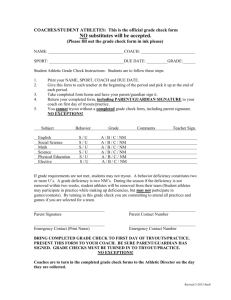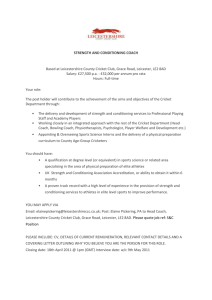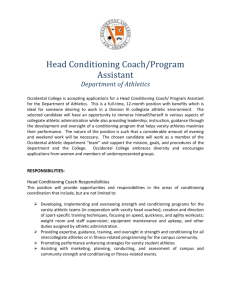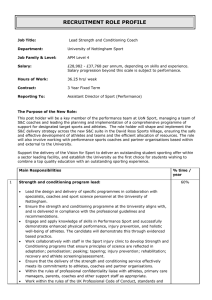Strength & Conditioning Coach - Rowan University
advertisement
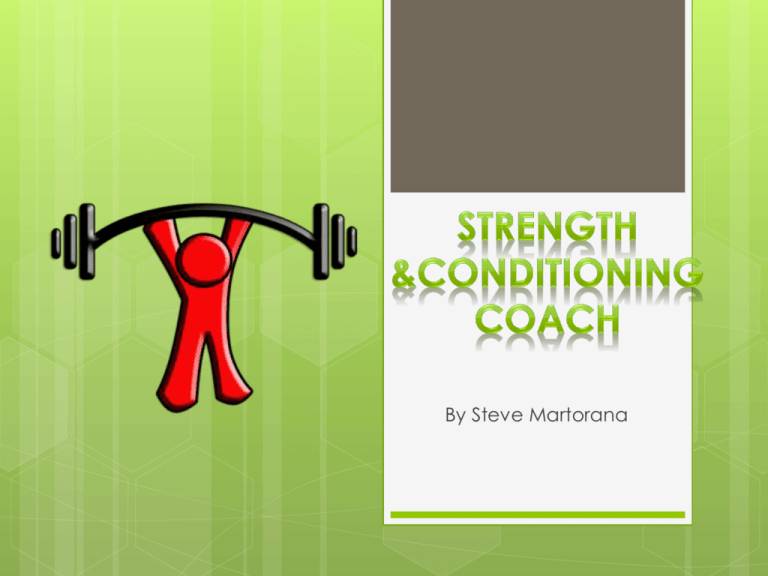
By Steve Martorana National Strength & Conditioning Association (NSCA) Founded in 1978 Started with 76 coaches Network, collaborate and unify strength & conditioning Currently over 30,000 members in 72 countries Strength & Conditioning Similar to personal trainers and Group exercise instructors Differ in one important way Improve performance or skill in sports Work primarily with athletes Two Main Goals Goal Improve athletic performance Goal #1 #2 Reduce athletic injuries Improving Athletic Performance Improving athletes’ speed, strength, and power Work closely with coaches Teaches proper lifting techniques Supervising/ motivating athletes during training Access performance before/after program IMPROPER Improving Athletic Performance (cont.) Conditioning on: programs vary depending If sport is in season or not The specific sport itself The position in each sport Off-Season vs. In season Off-Season Training is more rigorous Focus on improving: Speed, strength, agility, flexibility, explosive strength, confidence In Season Focus on maintaining condition rather than improvement Injury prevention Reducing Athletic Injuries Programs designed to strengthen body parts prone to injury Proper training techniques Monitor athletes overall health Give nutritional advice or refer to dietitian Ouch!!! Dealing with Injuries Work with athletic training and sports medicine staff Devise a program that corresponds with athlete’s injury Often work with parents if they have younger clients (such as in high school) Personal Skills & Abilities Strength and conditioning coaches should be: Good motivators Organized A good teacher Perceptive Good with people Let’s go! One more rep! Push yourself!! Education and Certifications Required BA degree Major in kinesiology Master’s degree required for college-level Required strength and conditioning certification: CSCS: Certified Strength & Conditioning Specialist Aspiring Strength & Conditioning Courses The following classes are in the coursework of most programs: Nutrition science Anatomy Physiology Kinesiology Exercise science Communication Psychology Professional ethics CSCS Certification NCSA administered Required CPR (cardiopulmonary resuscitation) certified Required AED (automated external defibrillator) certified 3 hour test 65.5% pass rate Experience Most important aspect when looking for a job Assistant, intern, or volunteer during college Working in fitness center Mentoring of a skilled strength and conditioning coach Future Opportunities Significant competition for jobs Have to have a good pedigree Hard to succeed with no experience Growing industry Strength-experts among top 5 most promising employment trend (study by ACSM) Place of Employment Strength hired by: and conditioning coach may be High schools Fitness centers Physical therapy clinics Universities Professional sport teams Different levels of coaching Collegiate Depends of the size and level of competition Iowa State(D1): 4 coaches to 450 athletes Central College (D3): 1 coach to 450 athletes Professional More coaches working with fewer athletes SA Spurs: 1 coach to 15 athletes Salary Vary depending on experience and qualifications Typically $40,000-$60,000 annually Rare cases make over $200,000 Professionals make more than colligate level Usually up to $100,000 Put your name out there Professional social websites can be very beneficial Ex. LinkedIn, Monster Intern with well-known coaches Coaches are willing to let younger people shadow them to get started “It’s not what you know, it’s who you know.” -Proverb Strength & Conditioning program Example of program with video: Boise State Football: http://www.boisestatefootball.com/video/pr ogram/strength-conditioning-0


